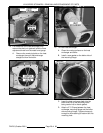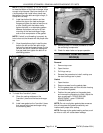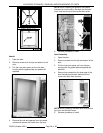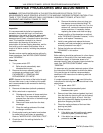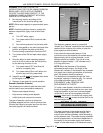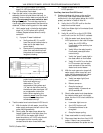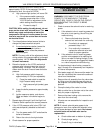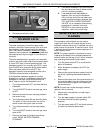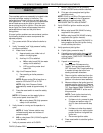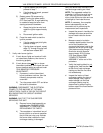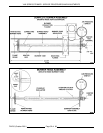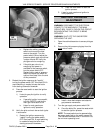
VHX SERIES STEAMER - SERVICE PROCEDURES AND ADJUSTMENTS
F24700 (October 2001) Page 28 of 68
Mechanical Pressure relief valve factory set to
approximately 15 PSI. If the pressure in the boiler
reaches this level, the valve will OPEN.
A. High pressure light (amber) will come ON.
1) If the pressure switch opens at a
pressure range other than 14.5 to
15.0 PSI then an adjustment to the
switch setting should be made.
a. Proceed to step 5.
CAUTION: While making the adjustment, do not
press on the wheel with extreme force. The
switch may rotate and develop a leak at the
compression fittings or in some cases, the rear
lead wire may touch the control box and create
an electrical short.
5. Turn the adjustment wheel several clicks to
change the pressure switch set point.
A. A counterclockwise
rotation lowers the
pressure switch set point while a
clockwise
rotation raises the pressure
switch set point.
NOTE:
For every click of the adjustment wheel
during rotation, the pressure setting is changed
approximately 1/8 PSI.
Make the adjustment
in small increments.
6. Raise the handle on the 15 PSI mechanical
pressure relief valve and open the valve for
approximately 4 minutes. This will exhaust
steam down the drain line and lower the boiler
pressure.
A. High limit pressure switch closes at
approximately 12 PSI (non-adjustable).
1) Press the reset switch to reset the
High Pressure safety control.
a. High pressure light (amber) goes
out.
B. Lower the boiler pressure to approximately
8 PSI.
C. Ignition sequence starts, main burner
lights and water in the boiler begins to
heat.
7. Repeat steps 4 through 6 until the High Limit
Pressure Switch opens at the correct pressure.
8. If the 13 PSI pressure relief valve (PRV- left
side) was temporarily disabled as outlined in
step 1:
A. Turn the power switch OFF and allow the
boiler to blowdown.
B. Return the valve to its original state.
9. Check steamer for proper operation.
FILL AND COLD WATER
SOLENOID VALVES
WARNING:
DISCONNECT THE ELECTRICAL
POWER TO THE MACHINE AT THE MAIN
CIRCUIT BOX. PLACE A TAG ON THE CIRCUIT
BOX INDICATING THE CIRCUIT IS BEING
SERVICED.
1. Check to ensure the solenoid valve is receiving
power.
A. If the solenoid valve is receiving power but
the valve is not opening, the coil may be
malfunctioning.
1) Remove the lead wires from the
solenoid coil and check for continuity.
a. If continuity is measured,
proceed to step "1. B.".
b. If no continuity is measured,
replace the solenoid valve and
check for proper operation.
B. If the solenoid valve is receiving power
and the valve appears to be opening but
little or no water is flowing through it, then
the valve ports may be clogged with debris
or a valve component malfunctioning.
2. To check solenoid valve further, proceed to
step 3 through 8 for disassembly and inspection
of internal components.
3. Shut water supply off, disconnect the water line
from the valve body then remove the solenoid
valve from the steamer.
4. Remove the coil assembly from the valve stem
by lifting up on the retaining cap at the top of
the solenoid valve and sliding the metal cover
plate off.
5. Clamp the body of the valve in a vise.
6. Mark a scribe line on the stem nut to the valve
body for proper re-tightening.
7. Remove the stem locking nut to remove the
stem from the valve body.
8. All parts are now accessible for inspection and
cleaning.
NOTE:
If internal solenoid parts appear to be
damaged or worn, then replace the solenoid valve.
Do not reuse damaged or worn parts.
No internal
solenoid parts are available as a service
replacement.
A. Check rubber seal on bottom of plunger.
B. Check plunger spring.
C. Check O-ring in valve body.



